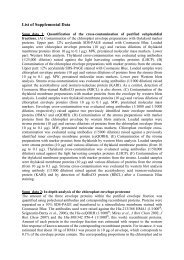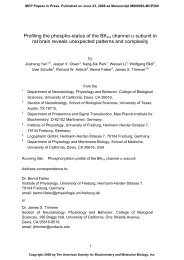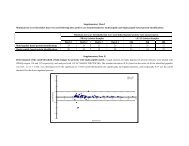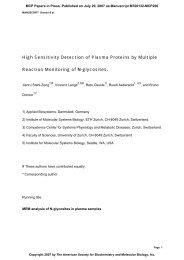Super-SILAC allows Classification of Diffuse Large B-cell ...
Super-SILAC allows Classification of Diffuse Large B-cell ...
Super-SILAC allows Classification of Diffuse Large B-cell ...
You also want an ePaper? Increase the reach of your titles
YUMPU automatically turns print PDFs into web optimized ePapers that Google loves.
amino acids and supplemented with 20% dialyzed fetal bovine serum. Cells were cultured for at least 6<br />
passages until they were fully labeled as assessed by quantitative mass spectrometry. Less than 1% <strong>of</strong><br />
tryptic peptides contained unlabeled arginine or lysine in the 9 labeled <strong>cell</strong> lines (Ramos, Mutu, Bl-41,<br />
U2932, OciLy3, BJAB, L1236, L428, DB) and less than 0.3% <strong>of</strong> identified peptides showed evidence <strong>of</strong> Arg<br />
to Pro conversion. Equal amounts <strong>of</strong> the heavy lysates were mixed to generate the super-<strong>SILAC</strong> mix.<br />
Protein Digestion and Fractionation – The super-<strong>SILAC</strong> mix (100 µg) was combined with an equal amount<br />
<strong>of</strong> the unlabeled <strong>cell</strong>s and further processed by the filter-aided sample preparation (FASP) method (21).<br />
In short, the sample was loaded on Microcon filters with a 30 kDa cut-<strong>of</strong>f (Millipore, Billerica, MA, USA),<br />
which <strong>allows</strong> the replacement <strong>of</strong> SDS with a urea containing buffer. The proteins were then alkylated<br />
with iodoacetamide followed by overnight trypsin digestion at 37°C in 50 mM ammonium bicarbonate.<br />
Peptides were collected from the filter after centrifugation and elution with water (2x).<br />
Using strong anion exchange chromatography, 40 �g <strong>of</strong> the peptide mixture from each replicate was<br />
fractionated (22). In summary, the strong anion exchange (SAX) was performed in tip-columns prepared<br />
from 200 μl micropipet tips stacked with six layers <strong>of</strong> a 3 M Empore Anion Exchange disk (1214–5012<br />
Varian, Palo Alto, CA). We used Britton & Robinson universal buffer (BRUB) composed <strong>of</strong> 20 mM acetic<br />
acid, 20 mM phosphoric acid, and 20 mM boric acid and titrated with NaOH to the desired pH for<br />
column equilibration and fraction elution. After loading the peptides at pH 11 and collecting it, five<br />
additional fractions were collected consecutively with buffers <strong>of</strong> pH 8, 6, 5, 4, and 3. The eluted fractions<br />
were desalted on reversed phase C18 Empore disc StageTips (23). Peptide elution was performed twice<br />
with 20 μl buffer B containing 80% acetonitrile (ACN) in 0.5% acetic acid. Organic solvents were removed<br />
by a SpeedVac concentrator to prepare the samples for analysis by LC-MS/MS.<br />
Liquid chromatography and MS for fractionation experiments – Eluted peptides were separated on an<br />
in-house-made 15 cm column with 75 µm inner diameter packed with ReproSil-Pur C18-AQ 3 μm resin<br />
(Dr. Maisch GmbH, Ammerbuch-Entringen, Germany) using an Easy nan<strong>of</strong>low high-performance liquid<br />
[6]








